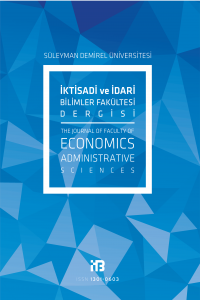TÜRKİYE’DE DÖVİZ KURUNUN ENFLASYONİST ETKİLERİ
Bu çalışmanın amacı, vektör otoregresif (vector autoregression: VAR) yöntemi yardımıyla Türkiye’de döviz kuru değişkenliğinin fiyatlar üzerindeki geçiş etkisini analiz etmektir. Ampirik kanıtlara göre, döviz kuru şokları orta ve uzun dönemde fiyatların tahmin hata varyansının yaklaşık %72’ini açıklar. Bu yüzden, döviz kuru ulusal enflasyonun tahmin hata varyansının önemli bir kaynağıdır
Anahtar Kelimeler:
Enflasyon, döviz kuru, vectörotoregresiv (VAR) analizi, Türkiye
Türkiye'de Döviz Kurunun Enflasyonist Etkileri
Keywords:
-,
___
- ALLSOPP, C. vd. (2006) “U.K. Inflation Targeting and the Exchange Rate,” Federal Reserve Bank of St. Louis, Working Paper, 2006-030A.
- BAILLIU, J. and E. FUJII (2004) “Exchange Rate Pass-Through and the Inflation Environment in Industrialized Countries An Empirical Investigation,”Working Papers from Bank of Canada, http://www.bank- banque-canada.ca/en/publication/pub res.html.
- BERUMENT, H. AND H. and M. PAŞAOĞULLARI (2003) “Effects of the Real Exchange Rate on Output and Inflation: Evidence from Turkey,” The Developing Economies, XLI-4 (December): 401–35.
- CALVO, G. vd. (1994) “Targeting the Real Exchange Rate: Theory and Evidence” D.C.:International Monetary Fund. Paper WP/94/22 Washington,
- CAMPA, J.M. and L.S. GOLDBERG (2002) “Exchange Rate Pass- Through into Import Prices: A Macro or Micro Phenomenon?” NBER Working Paper, No. 8934.
- CHAREZMA, W. W. and D. F. DEASDMAN (1993) New Directions in Econometric Practice, USA: Edward Elgar.
- DAVİDSON, R and J. G. MACKINNON (1993) Estimation and Inference in Econometrics, London: Oxford University Presss.
- DEVEREUX, M.B. and C.ENGEL (2002) “Exchange Rate Pass- Through, Exchange Rate Volatility, and Exchange Rate Disconnect,” NBER Working Paper, No. 8858.
- DORNBUSCH, R. (1976). “Expectations and Exchange Rate Dynamics”, Journal of Political Economy, 84: 1161-1176.
- DORNBUSCH, R. (1987) “Exchange Rate and Prices,” American Economic Review, 77-1: 93-106.
- DORNBUSH, R. vd. (1990) “Extreme Inflation: Dynamics and Stabilisation,” Brooking Papers on Economic Activity, No.2: 1–64.
- EDWARDS, S. (2006) “The Relationship Between Exchange Rates and Inflation Targeting Revisited,” NBER Working Paper, No. 12163.
- ENDERS, W. (1995) Apllied Econometric Time Series,John Wiley and Sons.
- FARUQUE, H. (2004) “Exchange Rate Pass-Through in the Euro Area: The Role of Asymmetric Pricing Behavior,” IMF Working Paper WP/04/14, International Monetary Fund.
- FEENSTRA, R. C. (1989) “Symmetric Pass-Through of Tariffs and Exchange Rates under Imperfect Competition: An Empirical Test,” Journal of International Economics, 27, 25-45.
- GOLDBERG, L. S. and J. M. CAMPA (2006) “Distribution Margins, Imported Inputs, and the Sensitivity of the CPI to Exchange Rates,” NBER Working Paper No.12121.
- GUJARATI, D: N. (1995) Basic Econometrics, McGraw-Hill, 3.Baskı
- HAHN, E. (2003) “Pass-Through of External Shocks to Euro Area Inflation,” Working Paper, No. 243, European Central Bank.
- ITO, T. and K. SATO (2006) “Exchange Rate Changes and Inflation in Post-Crisis Asian Economies: VAR Analysis of the Exchange Rate Pass- Through,” NBER Working Paper, No. 12395.
- JOHANSEN, S. (1995) Likelihood Based Inference in Cointegrating Vector Autoregressive Models, NewYork: Oxford University Press.
- KARMIN, S.B. (1996) “Exchange Rates and Inflation in Exchange-Rate Based Stabilization: An Empirical Examination,” International Finance Discussion Paper, No. 554. Washington, D.C.: Federal Reserve Board.
- KİBRİTÇİOĞLU, A. ve B. KİBRİTÇİOĞLU (1999) “Ham Petrol ve Akaryakıt Ürünü Fiyat Artışlarının Türkiye’deki Enflasyonist Etkileri,” T.C. Başbakanlık Hazine Müsteşarlığı, Araştırma ve İnceleme Dizisi: 21.
- LANDON, S. and C. E. SMITH (2006) “Exchange Rates and Investment Good Prices: A Cross-industry Comparison,” Journal of International Money and Finance, 25: 237– 256.
- LANDRY, A. E. (2005) “Expectations and Exchange Rate Dynamics:A State-Dependent Pricing Approach,” Job Market Paper, Boston University.
- McCALLUM, B.T. and E. NELSON (1998) “Nominal Income Targeting in an Open-Economy Optimizing Model,” NBER Working Paper, No. 6675.
- McCARTHY, J. (1999) “Pass-Through of Exchange Rates and Import Prices to Domestic Inflation in Some Industrialized Economies,” Bis Working Papers, No. 79.MINELLA, A. vd. (2002) “Inflation targeting in Brazil: Lessons and Challenges,” BIS Papers, No. 19.
- MONTIEL, P. (1989) “Empirical Analysis of High-Inflation Episodes in Argentina, Brazil and Israel,” IMF Staff Papers, 36 (3): 527–549.
- OBSTFELD, M. (2002) “Exchange Rate and Adjustment: Perspectives from the New Open Economy macroeconomics,” Monetary and Economic Studies, 23-46.
- OBSTFELD, M. and K. Rogoff (2000) “New Directions for Stochastic Open Economy Models,” Journal of International Economics, 50: 117- 153.
- OBSTFELD, M. and K. Rogoff, (1995) “Exchange Rate Dynamics Redux,” Journal of Political Economy, 103: 624-660.
- ODUSOLA, A. F. and A. E. AKINLO (2001) “Output, Inflation, and Exchanger Rate in Developing Countrties: An Application to Nigeria,” The Developing Economies, XXXIX-2, 199-202.
- QUIİRK, P.J. (1996) “Exchange Rate Regimes as Inflation Anchors,” Finance and Development, 33: 42-45.
- SIMS, C. A. (1980) “ Macroeconomics and Reality,” Econometrica, 48:1-49.
- TAYLOR, J. B. (2000) “Low Inflation-Pass Through and Pricing Power of Firms,” Europen Economic Review, 44:1389-1408.
- ISSN: 1301-0603
- Yayın Aralığı: Yılda 3 Sayı
- Başlangıç: 1996
- Yayıncı: Süleyman Demirel Üniversitesi
